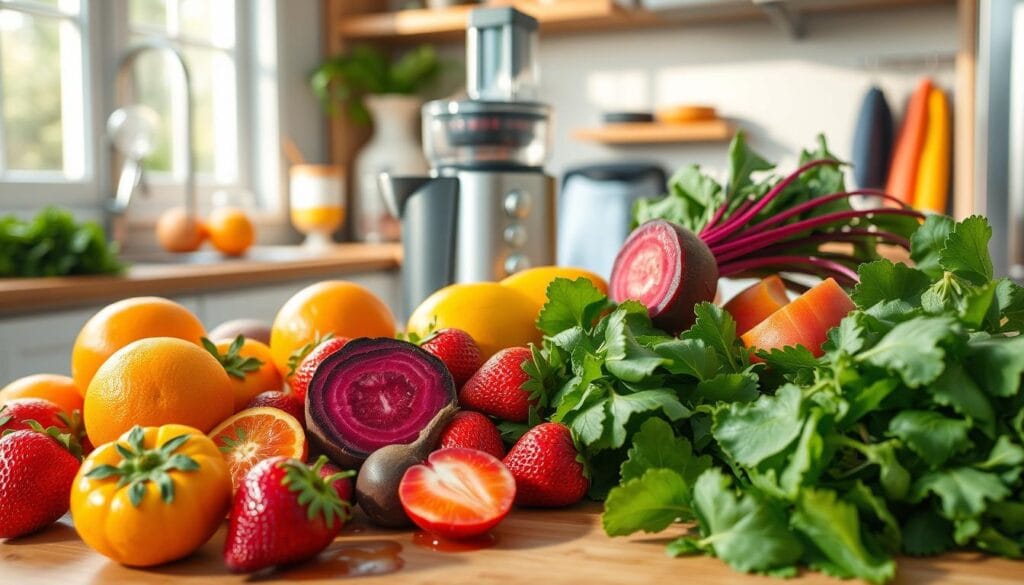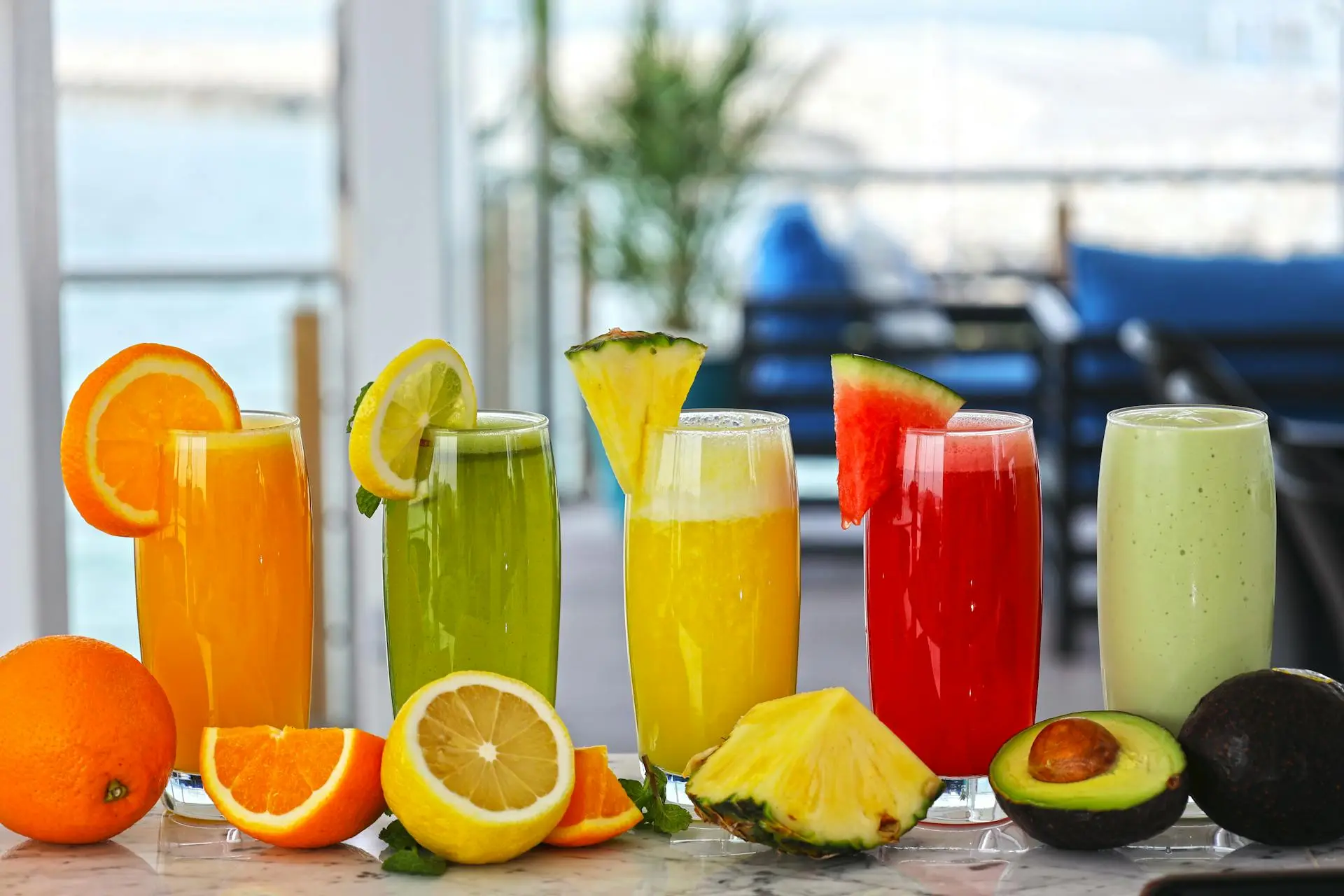Welcome to the world of juicing, where you can make tasty and healthy juices at home. As a beginner, it’s key to know the basics of juicing. You’re about to start a journey to learn the benefits of juicing and make your own juices.
In this guide, you’ll find out about the must-have equipment and the best fruits and veggies for juicing. You’ll also get beginner-friendly recipes. Whether you want to boost your health or just try something new, this guide is for you. You’ll learn how to make juices that fit your taste and diet.

By following this guide, you’ll make your own juicing recipes and enjoy fresh juice’s benefits. You’ll learn from the basics to making your own unique juice recipes. You’ll discover the best fruits and veggies, how to prepare them, and mix them for tasty and healthy juices.
Table of Contents
Understanding the Basics of Juicing
Starting your juicing journey means learning the basics. Juicing pulls out the liquid from fruits and veggies. You can use a juicer or blender for this. This liquid is packed with vitamins, minerals, and antioxidants, boosting your health.
Exploring juicing basics, you’ll find different methods and tools. It’s key to know the difference between juicing and blending. Juicing gets just the liquid, leaving pulp and fiber behind. Blending, on the other hand, mixes everything into a smoothie.
- High concentration of vitamins and minerals
- Rich in antioxidants
- Can improve overall health and wellbeing
Learning these basics helps you make tasty, healthy juices. You can create recipes that fit your taste and health needs.
Essential Equipment for Your Juicing Journey
When you start juicing, the right juicing equipment is key. A top-notch best juicer is vital for squeezing juice from your favorite fruits and veggies. There are many juicers out there, so pick the one that fits your needs best.
Think about these things to begin:
- Type of juicer: centrifugal, cold-press, or masticating
- Speed and power
- Ease of use and cleaning
- Price and brand reputation
A best juicer might cost a bit, but fresh juice is worth it. Having a reliable juicing equipment at home is convenient. Look for brands known for quality and easy-to-use juicers, perfect for beginners.
To find the best juicer for you, do your homework. Compare models, read what others say, and think about your budget and lifestyle. The right juicing equipment will kickstart your juicing journey and bring you fresh juice benefits.
| Juicer Type | Pros | Cons |
|---|---|---|
| Centrifugal | Fast and easy to use | Noisy and less efficient |
| Cold-press | High-quality juice and quiet | Slow and expensive |
| Masticating | Efficient and easy to clean | Slow and expensive |
Best Fruits and Vegetables for Juicing
Choosing the right fruits and vegetables is key for healthy juice recipes. Start by picking easy-to-juice options with great taste. Apples, oranges, and grapes are perfect for beginners.
Some of the best fruits for juicing include:
- Apples: rich in antioxidants and fiber
- Oranges: high in vitamin C and flavonoids
- Grapes: packed with vitamins and minerals
Vegetables also make great additions to your juices. Carrots, beets, and cucumbers are easy to juice and full of nutrients. Mixing these with fruits can elevate your juicing experience.
Try different fruit and vegetable mixes to find your favorite flavors and nutrients. Always pick fresh, organic produce for the best taste and health benefits.
Beginner-Friendly Juicing Recipes
Now that you have the right tools and know the best fruits and veggies for juicing, it’s time to start. Try easy juice recipes like orange and carrot, or go for something different like pineapple and coconut.
Here are some beginner-friendly recipes to kick off your juicing journey:
- Classic Orange: Mix 2 oranges, 1 carrot, and 1 apple for a tasty and healthy drink.
- Green Goddess: Blend 2 cups of spinach, 1 cup of green apple, and 1/2 cup of cucumber for a juice full of nutrients.
- Tropical Temptation: Combine 1 cup of pineapple, 1 cup of coconut water, and 1/2 cup of mango for a sweet and refreshing drink.
Don’t be afraid to try new combinations of fruits and veggies to find your favorite easy juice recipes. Adding a bit of lemon or lime juice can also make a big difference in taste.
With these beginner-friendly recipes, you’re ready to make your own unique and tasty juices. Enjoy your juicing journey!
| Recipe | Ingredients | Benefits |
|---|---|---|
| Classic Orange | Oranges, carrots, apples | High in vitamin C and antioxidants |
| Green Goddess | Spinach, green apples, cucumbers | Rich in iron and anti-inflammatory compounds |
| Tropical Temptation | Pineapples, coconut water, mangoes | High in vitamin C and manganese |
Preparation Techniques for Perfect Juice
To make the perfect juice, you need to know how to prepare it. Start by washing and cutting your fruits and veggies. This step is key to remove dirt, bacteria, and pesticides.
After preparing your produce, think about the juicing order. It depends on your juicer type, but start with softer fruits then harder veggies. This order helps you get more juice and less waste.
Speed and pressure matter when juicing. Too much pressure can make the juice quality drop. Too little pressure means less juice. Finding the right balance is key to a perfect, tasty, and healthy juice.
- Use a gentle touch when feeding produce into the juicer
- Apply consistent pressure to ensure even extraction
- Monitor the juice flow and adjust the pressure as needed
By following these tips, you can make a perfect juice that suits your taste. Always use fresh, quality produce. Try different mixes to find your favorite flavors.
Nutritional Benefits of Different Juice Colors
Exploring juice nutrition shows that different colors have unique health perks. From green to orange, each color brings its own set of nutrients. Knowing these benefits helps you make tasty and healthy juices that fit your needs.
The color of your juice often hints at its nutritional value. Green juices are full of antioxidants and anti-inflammatory compounds. They’re great for boosting health. Orange juices, on the other hand, are rich in vitamin C and beta-carotene. These support immune health and vision.
Here are some key benefits of different juice colors:
- Green juices: rich in antioxidants, anti-inflammatory compounds, and essential minerals like calcium and iron
- Orange juices: high in vitamin C, beta-carotene, and flavonoids, which support immune function and healthy vision
- Red juices: packed with lycopene, an antioxidant that can help reduce the risk of certain cancers and heart disease
- Yellow juices: good source of vitamin C, potassium, and flavonoids, which support healthy digestion and immune function
Mixing different juice colors in your diet ensures you get a wide range of nutrients. Whether you want to boost energy, support immunity, or just enjoy a healthy drink, knowing the benefits of each color helps. By picking the right fruits and veggies, you can make juices that are not only tasty but also packed with nutrients. This makes them a fantastic addition to your daily routine. Juice Color Nutritional Benefits Green Antioxidants, anti-inflammatory compounds, calcium, iron Orange Vitamin C, beta-carotene, flavonoids Red Lycopene, antioxidants, heart health Yellow Vitamin C, potassium, flavonoids
Common Juicing Mistakes to Avoid
Starting your juicing journey? It’s key to know the common mistakes that can mess up your juice’s taste and health benefits. These errors can make your juice taste bad, lose its nutritional value, or even harm your juicer. Knowing these mistakes helps you make tasty, healthy juice every time.
Common mistakes include picking the wrong ingredients, making technical errors, and storing juice wrong. For example, too many sweet ingredients can ruin the flavor. Not cleaning your juicer can lead to bacteria. And, storing juice wrong can cause it to lose nutrients and spoil faster.
Ingredient Selection Errors
Choosing the right ingredients is critical. You should mix fruits and veggies that taste good together and are healthy. Too many sweet ingredients can upset the flavor and health of your juice. Try to use less sweet stuff and add more leafy greens, citrus, and other healthy veggies.
Technical Mistakes
Technical errors can also mess up your juice. Not juicing right or not cleaning your juicer can lower your juice’s nutritional value. To avoid this, follow your juicer’s instructions and clean it often to stop bacteria.
Storage Problems
Storing your juice wrong can also be a problem. Make sure to keep it in a sealed container in the fridge and drink it within a couple of days. Freezing your juice can also help keep its nutrients and extend its life.
Knowing these common mistakes and how to avoid them helps you make great juice. Always pick the right ingredients, use the right technique, and store your juice right. This way, you’ll get the most from your juicing.
| Common Juicing Mistakes | How to Avoid |
|---|---|
| Ingredient selection errors | Choose a balance of fruits and vegetables |
| Technical mistakes | Follow manufacturer’s instructions and clean juicer regularly |
| Storage problems | Store juice in airtight container in refrigerator and consume within a day or two |
Advanced Juicing Tips and Techniques
As you get better at juicing, you’ll want to try advanced juicing techniques. This means experimenting with new flavors and ingredients. You’ll also learn to work with different types of produce.
Some tips for advanced juicing include:
- Trying out new and exotic ingredients, such as turmeric or ginger
- Experimenting with different combinations of fruits and vegetables
- Using various juicing techniques, such as cold-pressing or centrifugal juicing
By using these advanced juicing techniques, you can make complex and tasty juice recipes. These recipes will boost your health and wellness. Always choose fresh and organic produce. Also, try new flavors and ingredients to keep your juices exciting.
With practice and patience, you’ll become a pro at advanced juicing. You’ll make juices that are not only delicious but also good for your health.
| Juicing Technique | Description |
|---|---|
| Cold-pressing | A method of juicing that uses a slow and gentle process to extract the juice from the produce |
| Centrifugal juicing | A method of juicing that uses a fast and powerful process to extract the juice from the produce |
Creating Your Own Signature Juice Recipes
As you get better at juicing, you’ll want to try new flavors and ingredients. This is where the fun starts, and you can show off your creativity. First, learn about flavor balancing. It’s about mixing different ingredients to make unique and tasty flavors.
When making your own juice recipes, think about flavor balancing. This means mixing sweet, sour, and bitter tastes for a great taste experience. For example, pair sweet fruits like apples or pineapples with sour citrus fruits like lemons or limes. Adding bitter ingredients like kale or spinach can balance out the sweetness.

To make your juice recipes even better, use seasonal ingredients. This makes your juices fresh and flavorful. It also lets you try new things. Some great seasonal mixes include:
- Summer: watermelon, mint, and lime
- Autumn: apple, cinnamon, and ginger
- Winter: citrus, kale, and pomegranate
- Spring: strawberry, spinach, and lemon
After you’ve made your signature juice recipes, write them down. This helps you improve your recipes and make changes. Use a journal or a note-taking app to keep track of your recipes. By trying new flavors and ingredients, you’ll create unique juice recipes that show off your style and taste.
Storing and Preserving Your Fresh Juice
After making your juice, it’s key to store it right. This keeps its nutrients and taste fresh. The right juice storage stops spoilage and lets you enjoy it longer.
Choosing the right containers is important for preserving juice. Glass or plastic containers work, but they must be airtight and clean. Here are some tips for storing your juice:
- Store your juice in the refrigerator at a temperature of 40°F (4°C) or below.
- Use airtight containers to prevent oxidation and spoilage.
- Label your containers with the date and time you made the juice.
Freezing or canning are also ways to keep juice fresh. Freezing is easy and keeps juice good for months. Canning is traditional but needs special gear. Here’s a table with storage times:
| Storage Method | Storage Duration |
|---|---|
| Refrigeration | 24-48 hours |
| Freezing | 3-6 months |
| Canning | 6-12 months |
By following these tips, you can enjoy your juice longer. Always check for spoilage before drinking. If it smells or tastes bad, throw it away.
Budget-Friendly Juicing Strategies
Starting your juicing journey can be exciting but pricey. Yet, with smart strategies, you can enjoy budget-friendly juicing. Buying produce in bulk is a great way to save. Items like carrots, apples, and oranges are often cheaper in bulk.
Using seasonal ingredients is another smart move. Produce in season is usually cheaper and just as nutritious. Frozen or canned options can also be affordable and healthy.
Here are some more tips for budget-friendly juicing:
- Plan your juice recipes around what’s on sale at the grocery store
- Use herbs and spices to add flavor instead of relying on expensive ingredients
- Make large batches of juice and freeze it for later
By using these tips, you can enjoy affordable juice without spending too much. The secret to budget-friendly juicing is being creative and flexible. With practice, you can make tasty, healthy juices that won’t drain your wallet.
| Ingredient | Cost | Nutritional Value |
|---|---|---|
| Carrots | $0.60 per pound | High in vitamin A and fiber |
| Apples | $1.00 per pound | High in antioxidants and fiber |
| Oranges | $1.20 per pound | High in vitamin C and flavonoids |
Conclusion: Your Journey to Juicing Success
Congratulations on starting your journey to a healthier life with juicing! This guide has shown you how juicing can change your daily routine. It brings many nutritional benefits and a fun taste experience.
Your juicing journey is unique, full of chances to try new things and find great recipes. You now know how to make tasty juices. These can make your life healthier and inspire others.
Enjoy the journey, be kind to yourself, and have fun! Juicing is a lifelong adventure that can make you feel your best. Share your juices with friends and family. Keep exploring the world of homemade juicing.
FAQ
What is the difference between juicing and blending?
Juicing pulls the liquid from fruits and veggies, leaving pulp and fiber behind. Blending mixes the whole fruit or veggie, including pulp and fiber, into a smoothie.
What are the benefits of fresh juice?
Fresh juice is packed with vitamins, minerals, and antioxidants. It offers a concentrated dose of nutrients to boost your health and well-being.
What types of juicers are available?
There are several juicer types, like centrifugal, cold-press, and masticating. Each has its own benefits and drawbacks. The right juicer for you depends on speed, efficiency, and ease of use.
What are the best fruits and vegetables for juicing?
Start with easy-to-juice fruits like apples, oranges, and grapes. Also, try veggies like carrots, beets, and cucumbers for their tasty flavors.
How do I prepare my produce for juicing?
Wash and cut your produce well. Follow the right juicing order and use the correct speed and pressure to get the most juice.
What are the nutritional benefits of different juice colors?
Different juice colors offer unique nutritional benefits. Green juice is rich in antioxidants, while orange juice has anti-inflammatory properties.
What are some common juicing mistakes to avoid?
Avoid common mistakes like choosing the wrong ingredients, making technical errors, and storing juice poorly. Being aware of these can help you make perfect juice every time.
How can I create my own signature juice recipes?
To make your own juice recipes, learn about flavor balancing and try new combinations. Document your recipes to use them again.
How do I store and preserve my fresh juice?
Storing juice right is key to keeping it fresh and nutritious. Use the right containers and follow storage guidelines to avoid spoilage.
How can I make juicing more budget-friendly?
To save money on juicing, buy produce in bulk, use affordable ingredients, and find budget-friendly recipes.

